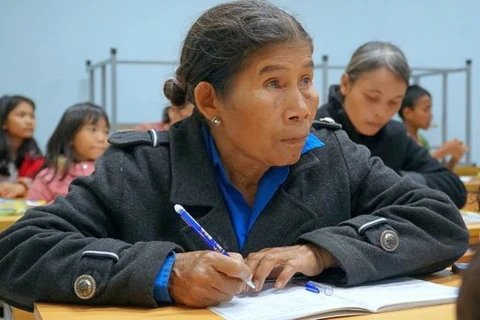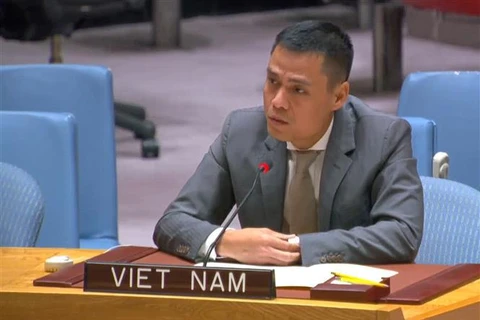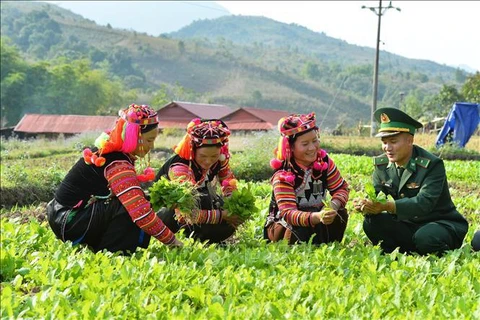 Honey harvesting at Doan Linh honey production facility in Minh Tam commune, Nguyen Binh district of Cao Bang province (Photo: VNA)
Honey harvesting at Doan Linh honey production facility in Minh Tam commune, Nguyen Binh district of Cao Bang province (Photo: VNA) Hanoi (VNA) – Along with support policies from the Party and State, education, especially vocational education, is considered one of the systematic and sustainable solutions to poverty.
A national survey on households living under and near the poverty line in 2022 according to the multidimensional poverty standards for the 2022-2025 period, which was released in January 2023, showed that the rate of such households was 7.52%, or over 1.97 million.
This year, the country’s poverty rate is estimated to decline to 2.93%, down 1.1%, while the rate of poor households in poor district is expected to stand at about 33%, a reduction of 5.62%, and the rate in ethnic minority groups is hoped to drop to 17.8%, completing the targets set by the National Assembly and Government.
However, according to the Ministry of Labour, Invalids and Social Affairs (MoLISA), poor people in Vietnam easily relapse, especially those from mountainous and ethnic minority-inhabited areas.
A report released by the ministry in the second half of 2022 indicated that the poverty reduction in Vietnam has yet to be sustainable, as the risk of relapsing and falling into poverty is high.
It clarified that 20% of households from ethnic minority groups who escaped from poverty in 2016 fell back into poverty in 2018, while the rate among Kinh and Hoa groups was 7.6%.
In the 2021-2025 period, total capital poured to the National Target Programme on Poverty Reduction is 28 trillion VND (1.14 billion USD). However, the sustainable poverty reduction has faced many difficulties as the majority of households living on and near the poverty line have countered a lack of sustainable livelihoods, especially those who lack professional skills.
MoLISA Deputy Minister Le Van Thanh said that in order to reduce poverty in a sustainable manner, it is necessary to promote internal strengths of the people and the community, with special focus on developing socioeconomic infrastructure, vocational training, creating jobs and improving income for the poor.
MoLISA’s data showed that in the 2016-2020 period, 38% of target households escaped poverty and 53% of families became well-off households after receiving short-term vocational training support, while 90% of people, after vocational training at intermediate and college levels, found stable jobs and enjoyed good income, and sustainably escaped poverty.
In the National Target Programme for Sustainable Poverty Reduction in the 2021-2025 period, vocational training and job creation have been included into a particular project with specific targets, roadmap and criteria.
The project aims to boost vocational training development in terms of scale and quality, providing vocational training support to the poor and people in poor areas, associating vocational training and job creation and sustainable livelihood development, increasing income and improving living conditions for labourers from poor and near-poor households as well as households that have newly escaped from poverty.
Dao Trong Do, head of the Continuing Training Department under MoLISA’s Directorate of Vocational Education and Training (DVET) said that vocational training is an effective approach to sustainable poverty reduction, which will solve the shortage in income and access to fundamental social services.
The World Bank and the International Labour Organisation (ILO) recommended that Vietnam should improve labour productivity and skills, which is the key pillar for sustainable poverty reduction and growth. Instead of providing short-term vocational training support, the country should focus on formal vocational training at vocational schools, they advised.
Lessons learned in some countries such as Bangladesh, the Philippines, and the Republic of Korea affirmed the success of linking vocational education with sustainable poverty reduction. For Vietnam, many research reports also indicated that vocational education has a direct impact on employment and income of households, affecting the poverty status of households.
The multidimensional poverty in the group of household heads who have graduated from college or university is less than 1%, while the poverty status of the group whose household heads have not completed primary school is up to 26.6%. The poverty rate decreased in households whose heads had higher levels of education, and the pace of poverty reduction in households whose heads worked without vocational skills was lower than in other household groups.
On May 28, 2020, the Prime Minister issued a directive on promoting the development of skilled human resources, contributing to improving labour productivity and increasing national competitiveness. participate in the new situation.
Accordingly, Vietnam strives to have vocational education approaching the level of ASEAN-4 countries (namely Indonesia, Malaysia, Thailand, and the Philippines) by 2030, and by 2045 approaching the level of G20 countries. This is an effective way for people to get rid of poverty without falling back again./.























